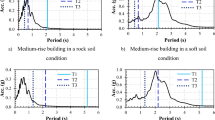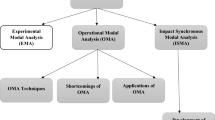Abstract
Numerical modeling of actual structural systems is a very complex task mainly due to the lack of complete knowledge on the involved parameters. Simplified assumptions on the uncertain geometry, material properties and boundary conditions make the numerical model response differ from the actual structural response. Improvements of the finite element (FE) models to obtain accurate response predictions can be achieved by vibration based FE model updating which uses experimental measures to minimize the differences between the numerical and experimental modal features (i.e. natural frequencies and mode shapes). Within this context, probabilistic model updating procedures based on the Bayes’ theorem were recently proposed in the literature in order to take into account the uncertainties affecting the structural parameters and their influence on the structural response. In this paper, a novel framework to efficiently estimate the posterior marginal PDF of the selected model parameters is proposed. First, the main dynamic parameters to be used for model updating are identified by ambient vibration tests on an actual structural system. Second, a first numerical FE model is developed to perform initial sensitivity analysis. Third, a surrogate model based on polynomial chaos is calibrated on the initial FE model to significantly reduce computational costs. Finally, the posterior marginal PDFs of the chosen model parameters are estimated. The effectiveness of the proposed method is demonstrated using a FE numerical model describing a curved cable-stayed footbridge located in Terni (Umbria Region, Central Italy).












Similar content being viewed by others
References
Allemang AJ (2003) The modal assurance criterion (MAC): twenty years of use and abuse. J Sound Vib 37:14–21
Au SK, Zhang FL, Ni YC (2013) Bayesian operational modal analysis: theory, computation, practice. Comput Struct 126:3–14. https://doi.org/10.1016/j.compstruc.2012.12.015
Bartoli G, Betti M, Facchini L, Marra A, Monchetti S (2017) Bayesian model updating of historic masonry towers through dynamic experimental data. Procedia Eng 199:1258–1263. https://doi.org/10.1016/j.proeng.2017.09.267
Bayes T (1763) An essay towards solving a problem in the doctrine of chances. Philos Trans R Soc 53:370–418
Beck JL (2010) Bayesian system identification based on probability logic. Struct Control Health Monit 17(7):825–847. https://doi.org/10.1002/stc.424
Beck JL, Katafygiotis LS (1998) Updating models and their uncertainties. I: Bayesian statistical framework. J Eng Mech 124(4):455–461 10.1061/(ASCE)0733-9399(1998)124:4(455)
Benedettini F, Gentile C (2011) Operational modal testing and fe model tuning of a cable-stayed bridge. Eng Struct 33(6):2063–2073. https://doi.org/10.1016/j.engstruct.2011.02.046
Bernardini E, Spence S, Gioffré M (2012) Dynamic response estimation of tall buildings with 3D modes: a probabilistic approach to the high frequency force balance method. J Wind Eng Ind Aerodyn 104–106:56–64. https://doi.org/10.1016/j.jweia.2012.03.014
Blatman G, Sudret B (2010) An adaptive algorithm to build up sparse polynomial chaos expansions for stochastic finite element analysis. Probab Eng Mech 25:183–197. https://doi.org/10.1016/j.probengmech.2009.10.003
Brincker R, Ventura C, Andersen P (2001) Damping estimation by frequency domain decomposition
Brincker R, Ventura CE (2015) Introduction to operational modal analysis. Wiley, Hoboken
Brincker R, Zhang L, Andersen P (2000) Modal identification from ambient responses using frequency domain decomposition. In: Proceedings of the international modal analysis conference—IMAC 1
Brownjohn JMW, Xia PQ (2000) Dynamic assessment of curved cable-stayed bridge by model updating. J Struct Eng 126(2):252–260. https://doi.org/10.1061/(ASCE)0733-9445(2000)126:2(252)
Choi SK, Canfield R, Grandhi R, Pettit C (2004) Polynomial chaos expansion with latin hypercube sampling for estimating response variability. AIAA J 42:1191–1198. https://doi.org/10.2514/1.2220
Daniell WE, Macdonald J (2007) Improved finite element modelling of a cable-stayed bridge through systematic manual tuning. Eng Struct 29(3):358–371. https://doi.org/10.1016/j.engstruct.2006.05.003
Ewins D (1984) Modal testing: theory and practice. Mechanical engineering research studies: engineering dynamics series. Research Studies Press, Letchworth
Field R, Grigoriu M (2004) On the accuracy of the polynomial chaos approximation. Probab Eng Mech 19(1):65–80. https://doi.org/10.1016/j.probengmech.2003.11.017
Fleming J, Engin AE (1980) Dynamic behaviour of a cable-stayed bridge. Earthq Eng Struct Dyn 8(1):1–16. https://doi.org/10.1002/eqe.4290080102
Gamerman D, Lopes H (2015) Markov Chain Monte Carlo: stochastic simulation for Bayesian inference. Chapmann & Hall, CRC, Boca Raton
Ghaffar AMA, Khalifa MA (1991) Importance of cable vibration in dynamics of cable stayed bridges. J Eng Mech 117(11):2571–2589. https://doi.org/10.1061/(ASCE)0733-9399(1991)117:11(2571)
Ghanem R, Spanos P (1991) Stochastic finite elements: a spectral approach. Am J Math 60:897–936
Gioffré M, Gusella V (2007) Peak response of a nonlinear beam. J Eng Mech 133(9):963–969. https://doi.org/10.1061/(ASCE)0733-9399(2007)133:9(963)
Gioffré M, Gusella V, Cluni F (2008) Performance evaluation of monumental bridges: testing and monitoring ’Ponte delle Torri’ in Spoleto. Struct Infrastruct Eng 4(2):95–106. https://doi.org/10.1080/15732470601155300
Hastings W (1970) Monte Carlo sampling methods using Markov chains and their applications. Biometrika trust, vol 57. Oxford University Press, Oxford
Jaynes ET (1957) Information theory and statistical mechanics. Phys Rev 106:620–630. https://doi.org/10.1103/PhysRev.106.620
Konakli K, Sudret B (2016) Polynomial meta-models with canonical low-rank approximations: numerical insights and comparison to sparse polynomial chaos expansions. J Comput Phys 321:1144–1169. https://doi.org/10.1016/j.jcp.2016.06.005
Marwala T (2010) Finite-element-model updating using computional intelligence techniques. Springer, London
Matthies HG (2007) Uncertainty quantification with stochastic finite elements. Encycl Comput Mech. https://doi.org/10.1002/0470091355.ecm071
McKelvey TP, Van Overschee P, De Moor B (1998) Book review: subspace identification for linear systems: theory, implementation, applications. Int J Adapt Control Signal Process 12(6):540–541. https://doi.org/10.1002/(SICI)1099-1115(199809)12:6<540::AID-ACS505>3.0.CO;2-L
Neal RM (2011) MCMC using Hamiltonian dynamics. Handbook of Markov Chain Monte Carlo
Peeters B, De Roeck G (1999) Reference-based stochastic subspace identification for output-only modal analysis. Mech Syst Signal Process 13:855–878
Pepi C, Gioffré M, Comanducci G, Cavalagli N, Bonaca A, Ubertini F (2017) Dynamic characterization of a severely damaged historic masonry bridge. Procedia Eng 199:3398–3403. https://doi.org/10.1016/j.proeng.2017.09.579
Rossi G, Marsili R, Gusella V, Gioffrè M (2002) Comparison between accelerometer and laser vibrometer to measure traffic excited vibrations on bridges. Shock Vib 9(1–2):11–18. https://doi.org/10.1155/2002/968509
Sap2000 (2018) Static and dynamic finite element of structures. Computers and Structures Inc, Berkeley
Saltelli A, Chan K (2000) Sensitivity analysis. Wiley, New York
Simoen E, De Roeck G, Lombaert G (2011) Resolution and uncertainty analysis of Bayesian FE model updating results. In: Proceedings of the 8th international conference on structural dynamics, EURODYN 2011, pp 2318–2325
Simoen E, Roeck GD, Lombaert G (2015) Dealing with uncertainty in model updating for damage assessment: a review. Mech Syst Signal Process 56–57:123–149. https://doi.org/10.1016/j.ymssp.2014.11.001
Sobol I (1993) Sensitivity estimates for non linear mathematical model. Math Comput Simul 1:56–61
Sobol I (2001) Global sensitivity indices for nonlinear mathematical models and their Monte Carlo estimates. Math Comput Simul 55(1):271–280. https://doi.org/10.1016/S0378-4754(00)00270-6
Sudret B (2008) Global sensitivity analysis using polynomial chaos expansions. Reliab Eng Syst Saf 93(7):964–979. https://doi.org/10.1016/j.ress.2007.04.002
Sudret B, Marelli S, Wiart J (2017) Surrogate models for uncertainty quantification: an overview. In: 2017 11th European conference on antennas and propagation (EUCAP), pp 793–797
Tarantola A (2005) Inverse problem theory and methods for model parameter estimation. Soc Ind Appl Math. https://doi.org/10.1137/1.9780898717921
Ren WX, Peng XL, Lin YQ (2005) Experimental and analytical studies on dynamic characteristics of a large span cable-stayed bridge. Eng Struct 27(4):535–548. https://doi.org/10.1016/j.engstruct.2004.11.013
Wiener N (1938) The homogeneous chaos. Am J Math 60:897–936
Xiu D, Karniadakis GE (2002) The Wiener–Askey polynomial chaos for stochastic differential equations. SIAM J Sci Comput 24(2):619–644
Yuen KV, Beck JL, Katafygiotis SL (2001) Efficient model updating and health monitoring methodology using incomplete modal data without mode matching. Struct Control Health Monit 13(1):91–107. https://doi.org/10.1002/stc.144
Author information
Authors and Affiliations
Corresponding author
Ethics declarations
Conflict of interest
The authors declare that they have no conflict of interest.
Additional information
Publisher's Note
Springer Nature remains neutral with regard to jurisdictional claims in published maps and institutional affiliations.
Rights and permissions
About this article
Cite this article
Pepi, C., Gioffre’, M. & Grigoriu, M.D. Parameters identification of cable stayed footbridges using Bayesian inference. Meccanica 54, 1403–1419 (2019). https://doi.org/10.1007/s11012-019-01019-x
Received:
Accepted:
Published:
Issue Date:
DOI: https://doi.org/10.1007/s11012-019-01019-x




